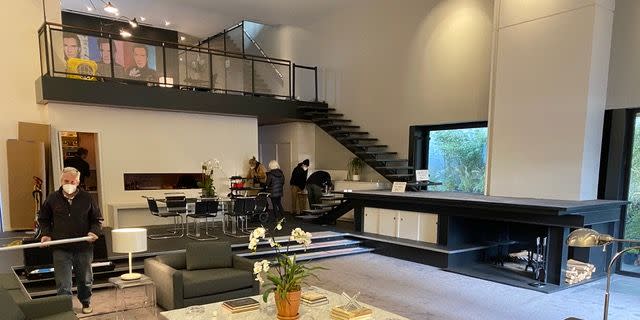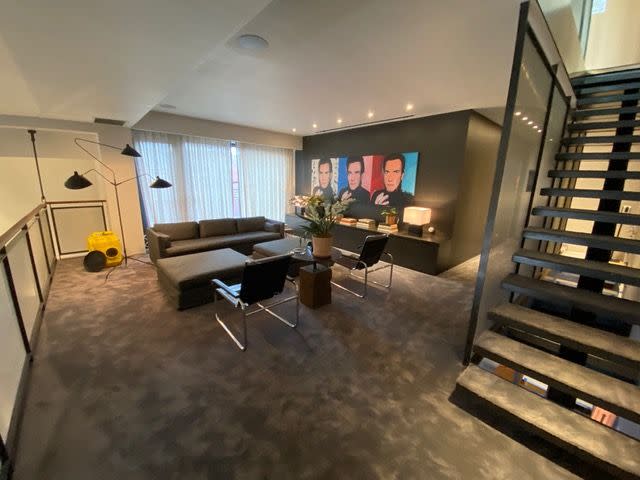Here's How a Production Team Replicated Halston's Apartment for the Netflix Series

- Oops!Something went wrong.Please try again later.
“Hearst Magazines and Verizon Media may earn commission or revenue on some items through the links below.”
Fashion designer Halston was best known for his minimalist yet classic creations—which graced the likes of Bianca Jagger and Elizabeth Taylor—and, as one would suspect, his New York City townhouse further echoed this timeless aesthetic in its own right, through its architectural makeup and interior decor. Naturally, a recreation of the designer’s home plays its own starring role in Netflix’s new miniseries Halston. To learn how this famed dwelling was revived for its appearance on the small screen, we spoke to the show’s production designer, Mark Ricker.
Before we delve into the formation of the replica townhouse, it’s important to note the history of the pad it was inspired by. The real life Halston House, as it’s called, is a designated historical landmark located on the Upper East Side of Manhattan—and it last sold in 2019 for $18 million to another legendary fashion designer: Tom Ford (who also owns the Billy Haines-designed Betsy Bloomingdale estate in Los Angeles).
In 1966, the property was remodeled by modernist architect Paul Rudolph, who helmed the creation of just two other properties in Manhattan. He was commissioned to modernize this abode—which was originally a carriage house, built in the 1800s—by the owners at the time, real estate lawyer Alexander Hirsch and his partner, Lewis Turner. Some years later, in 1974, Halston purchased the property, where he resided until 1989. During this time, countless star-studded parties were held here, for guests including Liza Minelli (who is also depicted in Halston), Andy Warhol, and Bianca Jagger, amongst others.

As part of the townhouse’s recreation for Halston, Ricker and his team worked on location at a private home in Red Hook, Brooklyn. “When I started the job, I assumed we would either shoot in the actual townhouse location, or we’d build it as a stage set,” Ricker tells House Beautiful. “It was too specific and iconic to do otherwise.” Given that the Halston House “had been rented out to parties, or productions, in the past,” Ricker “figured our chances were high.” However, because the property is a private residence, it “was not an option for shooting.”
Additionally, because Halston’s budget didn’t allow for a fully built set—and because there was no stage space available in Manhattan that could accommodate the height of this particular set, says Ricker—the production team instead scouted nearby locations including lofts, empty storefronts, and houses, with hopes to transform one of these spaces into something Halston himself would approve of. Finally, they found their match in a Brooklyn abode on a corner lot.
So, how does the replica townhouse compare with the original? Ricker discloses that the manmade set had wider dimensions than the real home, which is a tactic often used in the entertainment world to allow for more space for the cast and crew when filming. Since the Brooklyn home they were filming in had various modern design elements, such as a contemporary kitchen, flats were built to conceal such details. Another intriguing makeshift component is what appears to be a shelf underneath a milk glass sliding window—but is actually part of a marble island in the kitchen. Talk about innovative design!

As for the decor of the duplicate dwelling, set decorator Cherish M. Hale and her assistant, Carol Nast, “sourced or manufactured all the furniture and details in the house,” says Ricker. All of the fabrics came from Corona Upholstery, a shop in Queens, while the dining room table was a 1stDibs find. And you probably noticed the recreated versions of Andy Warhol’s portraits of Halston himself and Jackie Kennedy; those were done by graphic artist Eddie Lofredda. As for that stone coffee table in the living room? It’s a six-foot-wide square-shaped piece of Carrara marble placed atop a vintage base.
Clearly, Halston’s Manhattan townhouse is as much a part of the designer’s legacy as his fashion creations are. "It represented everything about him in terms of style, glamour, sophistication, minimalism, and sex,” as Ricker points out. “The Paul Rudolph-designed townhouse was a stand alone in terms of architecture—and it became iconic as an interior when Halston hosted parties there.”
Follow House Beautiful on Instagram.
You Might Also Like

